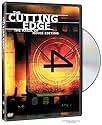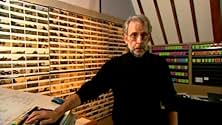IMDb RATING
7.7/10
3.3K
YOUR RATING
Documentary about the art of film editing. Clips are shown from many groundbreaking films with innovative editing styles.Documentary about the art of film editing. Clips are shown from many groundbreaking films with innovative editing styles.Documentary about the art of film editing. Clips are shown from many groundbreaking films with innovative editing styles.
Kathy Bates
- Narrator
- (voice)
- Director
- Writer
- All cast & crew
- Production, box office & more at IMDbPro
Featured reviews
This is a first-rate job of work, one of the best documentaries on film-making that I've ever seen, opening up the fascinating world of film editing by letting great editors and directors speak to us directly about the mysteries of film cutting--supported by illuminating examples drawn from real films. I can't praise too highly the thoughtful choice of speakers, from Thelma to Dede to Walter Murch and on down the line. Nice to see director Joe Dante too. I was particularly pleased at the inclusion of early film editing examples, such as Dziga Vertov's Man With a Movie Camera and, of course, the down-the-stairs sequence from Potemkin. (The film includes a few sequences from later films that echo the Potemkin sequence, but I bet there's at least five examples they missed!) Bravo! Michael Goodwin
8donf
This is a remarkable documentary, informative, interesting and successful in clarifying what is, for many, something of a mysterious process. The contributions to film making of directors, actors, designers, cinematographers and sound recordists is self evident, but the film editor's role has seldom been understood nor its importance fully recognised. This documentary is the first to give directors and editors an opportunity to explain exactly what goes on in the editing room and they have done it superbly. What a pity then, that references to the history of film editing woven into this story are cursory, inadequate and in some instances completely wrong. Martin Scorsese refers to Edwin Porters' 1902 film, Life of an American Fireman, as the very first film to be edited using crosscutting as a structuring device, and the commentary supports this view, despite convincing evidence to the contrary that was discovered in 1978. In fact the earliest discovered examples of this practise date from 1906. Equally mistaken is the assertion, made several times in this prize-winning documentary, that D.W.Griffith originated the important editing practise of action matching. In fact there is clear evidence of action matching in a British film made as early as 1903 and Griffith's first film was not made until 1908. There is considerable evidence that Griffith considered action matching to be of very little importance, and when used in his films it is often ill judged and clumsy. All this is curious in a documentary that seeks to explain the history and practise of film editing. One might have expected research on the topic to be as well informed as the comments made by most of the contributors, particularly given that the scriptwriter is Professor Mark Jonathan Harris of the School of Cinema and Television, University of Southern California.
In the 80's I watched a Hollywood how-it's-done film called "Scream Greats." It was the how-tos of horror. They showed many of the tricks for the blood, guts, and gore that I was sneaking to watch.
"Cutting Edge," I would say, is the partner to that film. To this point I had no idea what a film editor was. If I was given a hundred guesses I probably wouldn't have gotten it right. They are the people who piece the movie together from the thousands of frames of film. They have to cut, splice, intersplice, and more. Regardless of what order the movie is shot in, the editors can put it together to give the viewer the impression that it was one seamless and chronologically cohesive movie. If a movie incongruously jumps from one scene to the next, that's the editor. If a movie has seamless transitions from one scene to the next, that's the editor. "Cutting Edge" was some really fun and eye-opening stuff to watch.
"Cutting Edge" gives a history of the film editor, some of the most influential film editors, and the methodology of some current film editors. These hidden heroes are essential to the movie making process--probably as important as anybody--yet so unheralded. If "Cutting Edge" does anything it gives them at least a little bit of just due.
"Cutting Edge," I would say, is the partner to that film. To this point I had no idea what a film editor was. If I was given a hundred guesses I probably wouldn't have gotten it right. They are the people who piece the movie together from the thousands of frames of film. They have to cut, splice, intersplice, and more. Regardless of what order the movie is shot in, the editors can put it together to give the viewer the impression that it was one seamless and chronologically cohesive movie. If a movie incongruously jumps from one scene to the next, that's the editor. If a movie has seamless transitions from one scene to the next, that's the editor. "Cutting Edge" was some really fun and eye-opening stuff to watch.
"Cutting Edge" gives a history of the film editor, some of the most influential film editors, and the methodology of some current film editors. These hidden heroes are essential to the movie making process--probably as important as anybody--yet so unheralded. If "Cutting Edge" does anything it gives them at least a little bit of just due.
This is a must see documentary for any serious film buff. For all you folks out there that dismiss older films, you may be surprised by your favorite directors such as Quentin Tarantino, Martin Scorsese, Steven Spielberg and James Cameron praising the magnificence of silent films and many classics. Without these classics and the skill involved in making them, today's movies wouldn't be what they are. A brilliant and informative documentary. It very thoroughly explores a movie art form that is often not understood and certainly unappreciated. The editing of a film is very instrumental in its success. However, not many people appreciate it.
Very fine feature length documentary lurking amidst the extras on my Bullitt Blu-ray disc. Little direct relevance to that film except that it did win an Oscar for editing and we do get to see some of the famous car chase. But never mind, all the better for not being directly related for this is a far reaching and informative piece. Kathy Bates narrates the early b/w footage and informs us that women were the first editors. It was considered somewhat related to sewing and stitching we are told and therefore appropriately relegated to ladies until sound came in and men had to be involved because that was far too technical. Before we have a chance to remonstrate we have Tarantino introducing his beloved editor Sally Menke and all is sweet and light. I had never seen Menke or fellow editors Walter Much, Craig McKay and others before and cannot even recall seeing Alexander Payne, Joe Dante or Lawrence Kasden, three of the numerous directors who also put in their pennies worth plus great little anecdotes. Informative, fast moving, colourful and of course, well edited.
Did you know
- TriviaThis documentary is featured on the Two-Disc Special Edition DVD for Bullitt (1968), released in 2005.
- Crazy creditsEmbedded throughout the beginning of the credits are photos of several film editors displaying the awards that they've won.
- ConnectionsFeatures L'Arroseur arrosé (1895)
- How long is The Cutting Edge: The Magic of Movie Editing?Powered by Alexa
Details
- Runtime
- 1h 39m(99 min)
- Color
- Sound mix
- Aspect ratio
- 1.85 : 1
Contribute to this page
Suggest an edit or add missing content






























